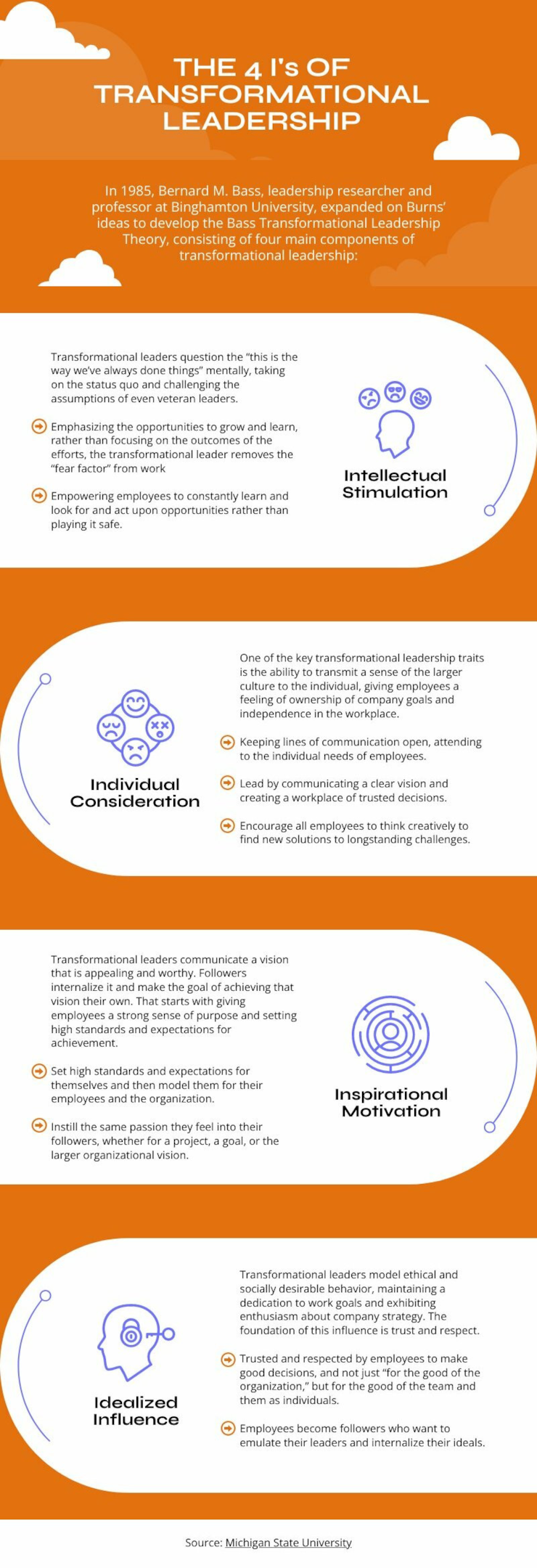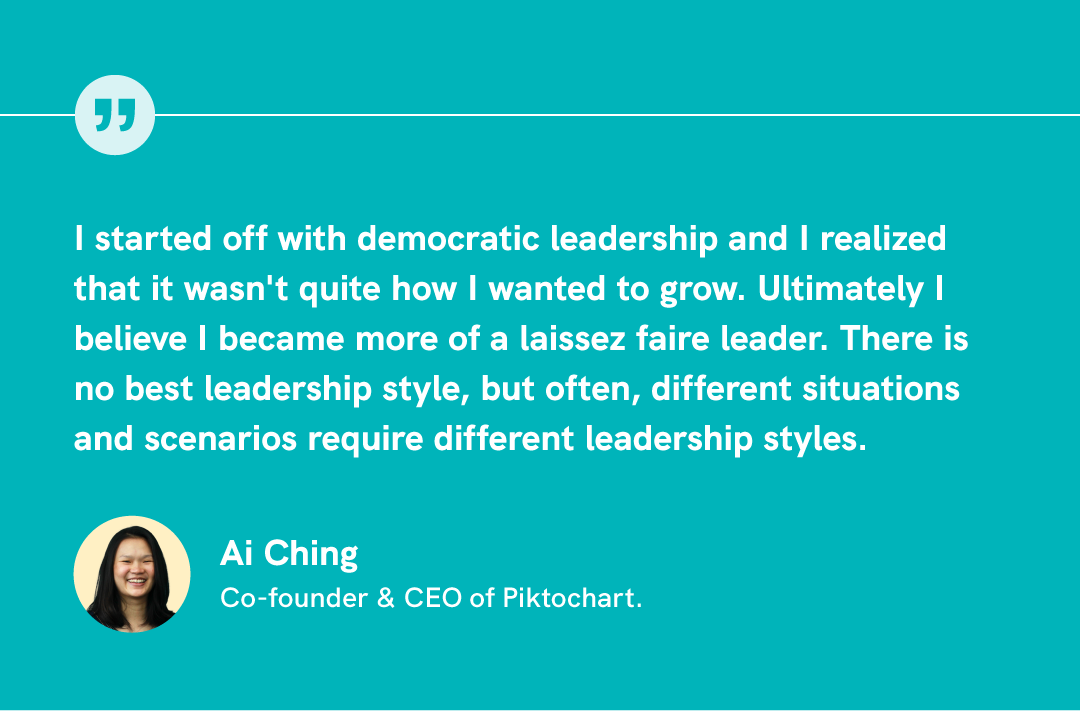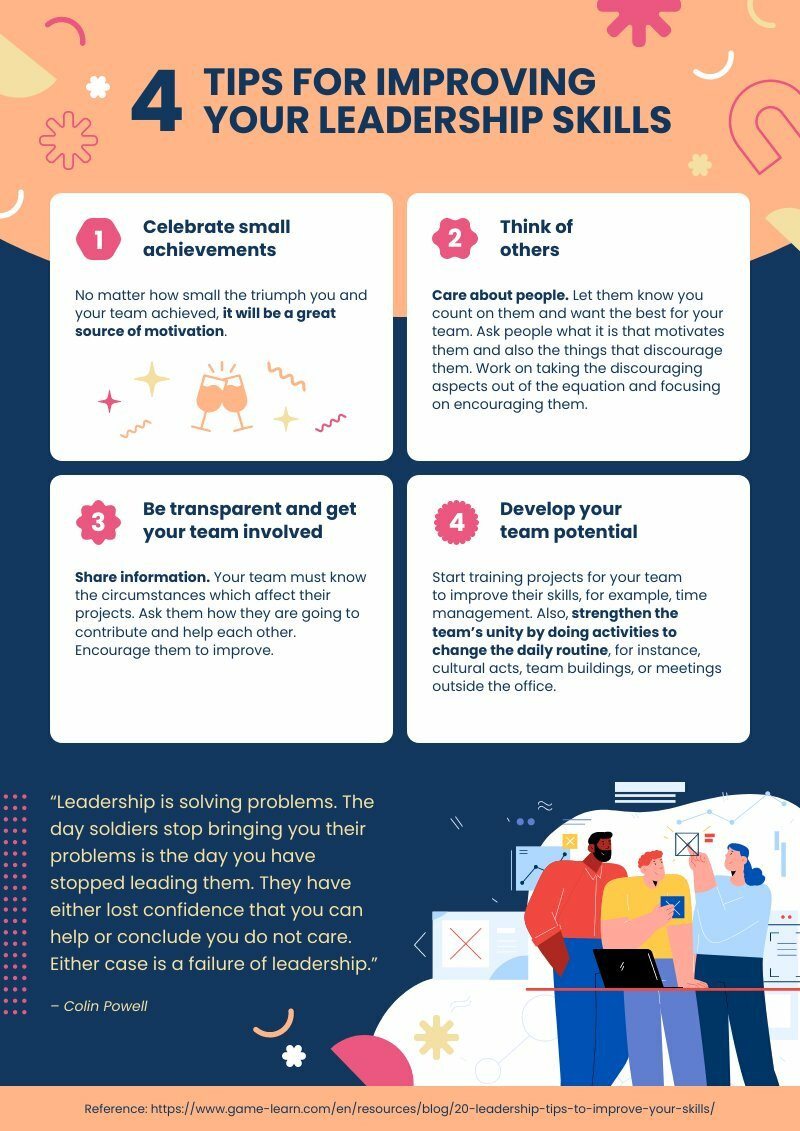I’ve always been fascinated with the concept of leadership. Growing up, I was inspired by my girl scout captain and how she managed to excel at seemingly all the most difficult tasks, the way my teacher Ooi made History lessons so memorable, and even how my dad ran his business through a never-ending series of challenges — all these experiences shaped my understanding of leadership.
Now, in my professional life, I’ve become even more intrigued by the many ways one can lead. I have run Piktochart with my husband for 12 years now, and we’ve had so much to learn in this journey.
At different points, I’ve found that each leadership style heavily impacts my decision-making process. Regardless of which leadership style, leaders develop emotional intelligence and excellent communication skills in order to be effective leaders.
I did not want this article to read like another Drucker “seven leadership styles” material, and I hope you’ll enjoy this material as much as I did while writing it!
Piktochart offers professionally-designed templates to create reports, presentations, brochures, and more. Try your brand color palette on templates within seconds. Sign up for a free account today to create impressive visuals with ease.
Table of Contents
What is a leadership style?
Before we embark on this journey, let’s get on the same page about what a “leadership style” is. A leadership style refers to a unique fingerprint. It’s the way a person guides, inspires, and manages others.
This ‘style’ is shaped by their personality, experiences, and the unique situations they face. Imagine if you were a captain of a ship 🚢 — your leadership style would be how you decide to navigate the waters, interact with your crew, and reach your destination.
No two leaders or organization are the same, and that’s the beauty of it! Your one leadership style works in tandem with your organizational culture. Some may be more hands-on, while others prefer to give their individual team members a lot of freedom.
The successful leader is him/her who can adapt their style to different situations and team members strengths. But understanding these styles can provide a toolbox 🧰 of techniques for anyone aspiring to lead effectively.
Why is it important to know your own leadership style?
Under the bright lights of leadership, it’s easy to think that the spotlight is on you.
But I’ve found that being a good leader is actually less about you and more about the people you’re leading. 🏃♀️🏃♂️
Everyone is unique and responds to different management style. As a leader, your job is to unlock the potential in your team, and knowing your leadership style can be the key that opens that door.
There’s another reason why I believe it’s crucial to know and develop your own style: it helps you understand your strengths and weaknesses.
Just like superheroes, leaders have their powers and their kryptonite. 🦸♀️🦸♂️
We’re all learning and growing. This article serves as a simple leadership assessment. As a leader, your journey doesn’t stop; knowing your style is just one important step along the way!
What are the 11 types of leadership styles?
Just remember you’re not choosing one of these effective leadership styles, you already have your own leadership approach and you’re about to enhance your leadership skills further.

1️⃣ Democratic Leadership
Democratic leadership style is like being on a team where everyone gets to have a say! It’s like playing a game where everyone contributes to the strategy. Imagine if Barack Obama, Nelson Mandela, and Indra Nooyi were on your team – these are great examples of democratic leaders.
Pros: Everyone feels heard and important, which can make people really happy at work! 😀
Cons: Sometimes decisions can take a long time because everyone gets to share their opinion. In my experience, it also can sometimes point to leadership being weak in an organization. “The desire to want to please people” can drive the business leader to make wrong decisions.
2️⃣ Autocratic Leadership
Autocratic leadership style is like having a teacher who decides everything in the classroom. Autocratic leaders like Martha Stewart, Steve Jobs, and Henry Ford are often booed for their authoritarian leadership style, but it gets the job done!
Pros: Decisions get made really fast. This leader focuses on delegative leadership. They may have some similarities with the bureaucratic leaders who follow a text book.
Cons: But, some people might feel sad because they don’t get to share their ideas. This may negatively impact job satisfaction as team members tend to want to have a say and own a project.
3️⃣ Laissez-faire Leadership
With Laissez-faire leadership, it’s like having a coach who lets you practice however you want. 🏀 Warren Buffett, Larry Page, and Sergey Brin are famous for this type of leadership. Laissez faire leaders have to find the right teams – “hire really smart and self motivated team members and get out of their way” would be a good philosophy.
Pros: You get a lot of freedom to do things your way! These business leaders tend to empower their team members with trust and autonomy.
Cons: Some people might feel lost without more guidance.
4️⃣ Strategic Leadership
Strategic leadership is like being a captain of a ship who sees the whole map. 🚢 Leaders like Sundar Pichai, Mary Barra, and Howard Schultz are known for their strategic leadership style.
Pros: The team has a clear direction and knows where it’s going.
Cons: Sometimes, the leader might focus too much on the future and not enough on what’s happening right now.
5️⃣ Transformational Leadership
Transformational leadership is like having a cheerleader who motivates you to be your best! 📣 Oprah Winfrey, Elon Musk, and Martin Luther King Jr. were transformational leaders. It’s also similar to the coaching leadership style, which is like having a personal trainer who helps you grow stronger. Think about coaching leaders like Sheryl Sandberg, Phil Jackson, and Tony Robbins.
Pros: You feel inspired and motivated to do your best!
Cons: Similar to a coaching leader 7️⃣ , if the leader’s not careful, they might expect too much and cause stress.

6️⃣ Transactional Leadership
Transactional leadership is like doing chores for an allowance. People like Bill Belichick, Vince Lombardi, and Anna Wintour are examples of the transactional leader.
Pros: You know exactly what you need to do to succeed.
Cons: It doesn’t encourage creativity, and you might get bored 😴 doing the same tasks.
7️⃣ Servant Leadership
Servant leadership style is like being the friend who’s always there to help. This type of leader puts others first and works hard to make sure everyone on the team is happy and doing well. They are like a superhero whose power is helping others! 💪
Some famous examples of servant leaders include Mother Teresa, who dedicated her life to helping others, and Mahatma Gandhi, who always put the needs of his people first.
Pros: As a servant leader, you make sure everyone feels valued and taken care of, which makes for a happy team! 😊
Cons: The tricky part is, sometimes servant leaders can focus so much on helping others that they might not make the best decision for the whole team or forget to take care of themselves.

8️⃣ Bureaucratic Leadership
Bureaucratic leadership style is like having a rule book 📖 that tells you exactly what to do. Leaders like Richard Nixon, Ray Kroc, and Jeff Bezos have shown this style.
Pros: Everyone knows exactly what to do.
Cons: It can feel too strict and doesn’t allow for much creativity.
9️⃣ Visionary Leadership
Visionary leaders are like having a leader who has a dream and shares it with everyone. Leaders like Walt Disney, Mark Zuckerberg, and Satya Nadella are known for this style.
Pros: It’s exciting to work towards a big dream!
Cons: Sometimes, people can lose sight of the smaller tasks that need to be done. These leaders have to be paired with strong operational abilities to ensure that the team is able to break the vision down to smaller pieces.
🔟 Pacesetting Leadership
Pacesetting leadership is like being in a race where the leader is running really fast! 🏃 Leaders like Jeff Bezos, Larry Ellison, and Marissa Mayer are known for this style.
Pros: The team can achieve a lot quickly.
Cons: But, they might feel stressed out trying to keep up.
1️⃣1️⃣ Situational Leadership
Situational leadership is like having a coach who changes the game plan based on what’s happening in the game. Famous leaders like Dwight D. Eisenhower, Paul Hersey, and Kenneth Blanchard are known for this style.
Pros: The leader can adapt to whatever is happening.
Cons: The team might get confused if the plan changes too often.



What is another leadership style not mentioned in the above?
Charismatic leadership
A charismatic leader is like the star of the show who can easily inspire and excite others with their energy and enthusiasm. Imagine a rockstar on stage, exciting the crowd — that’s what a charismatic leader can do! 🎸
Some examples of charismatic leaders include Martin Luther King Jr., who inspired millions with his “I Have a Dream” speech, and Steve Jobs, who was known for his exciting presentations at Apple.
We have not included this style above, as it feels like it’s more of a feature than an actual style. For example, Martin Luther King Jr is a democratic leader while Steve Jobs was an autocratic leader.

What are the most common leadership styles?
The transformational leadership is the most common style! And it’s easy to see why.
- Inspires and Motivates: Transformational leaders are typically charismatic and inspiring. They have a vision and are excellent at getting their team excited about it. People want to work for leaders who make them feel motivated and valued, which is why this style is often seen.
- Focuses on Change and Innovation: This style of leadership is about transforming and changing the organization. In today’s rapidly changing world, organizations need to be adaptable and innovative. Transformational leaders typically thrive in these environments, making it a common leadership style.
- Encourages Personal Growth: Transformational leaders not only want to change the organization, but they also aim to help their team members grow and develop. They often place a strong emphasis on mentorship and development, which can lead to a more engaged and loyal team.
- Results in High Performance: Studies have found that transformational leadership often leads to high levels of satisfaction and performance among team members. Because of this, many leaders aspire to this style, and many organizations seek to cultivate it.

In other words, a transformational leader is a well-balanced leader focusing on people as well as results. It’s also able to navigate changes we

A little note before we close
I started off with democratic leadership, and I realized that it wasn’t quite how I wanted to grow. Ultimately I believe I became more of a laissez-faire leader. There is no best leadership style, but often, different situations and scenarios require different leadership styles.

There isn’t quite a wrong or right leadership style for everyone, but I’m hoping that this article has given you some food for thought! It’s important to know thyself and then, help to lead your team/company better.



